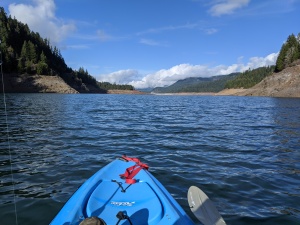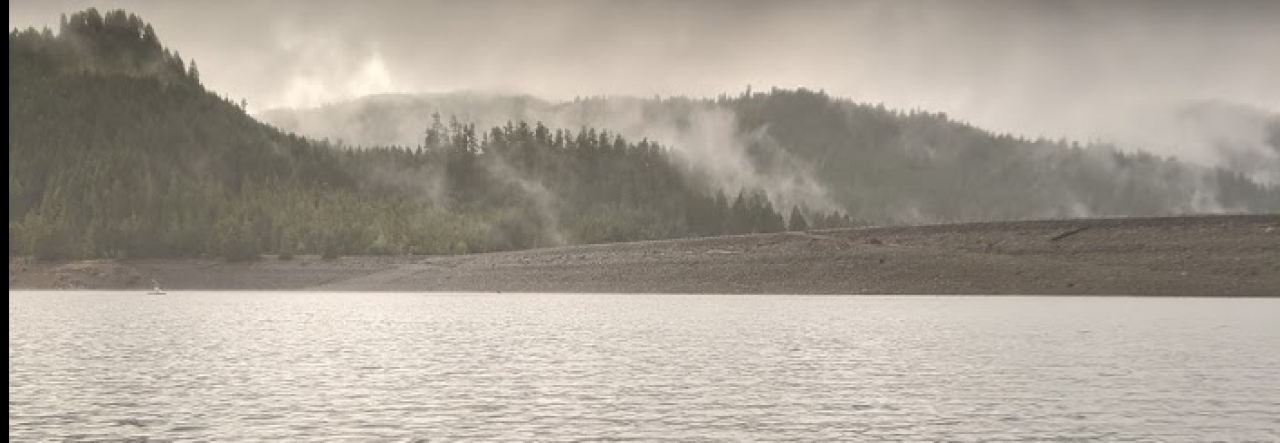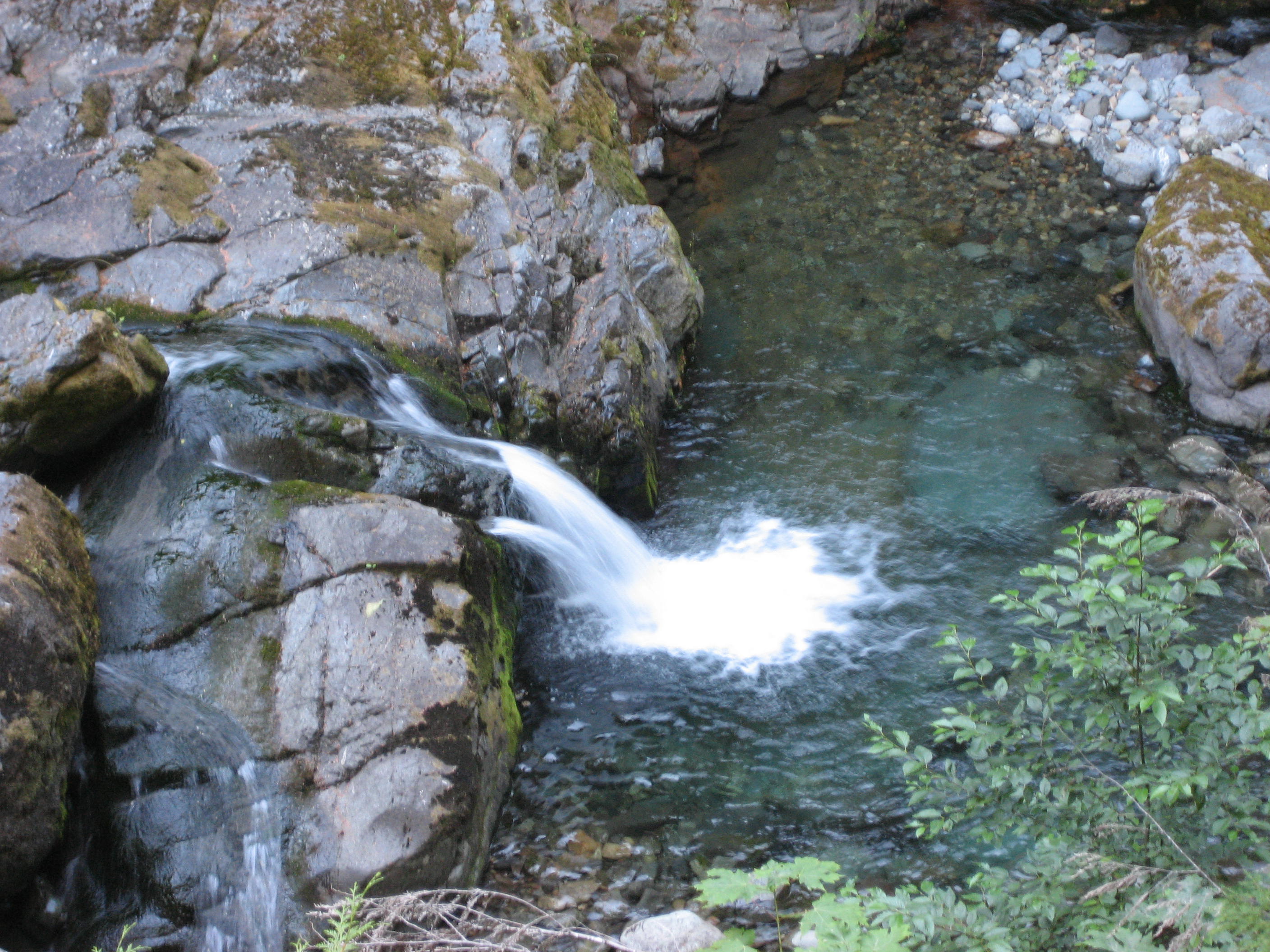For a trip to Oregon’s mining past you can take a back roads drive to the Bohemia mining zone east of Cottage Grove. The roads up to the area are not for the faint of heart or for those in little yuppie cars. Parts of the road are very steep and you will need a four-wheel drive vehicle with good clearance to get up there. The roads do not usually clear of snow until late in June depending on the snowfall for the winter. On your way up to the mine on Champion creek, if you know where to look there is a broken seam in the side of the road that is where an old blacksmith used to have his shop setup. Most of the seam was broken off when the current road was put in, but if you climb up in it you can still see the soot marks on the ceiling.
Directions: To get there, drive south on I-5 from Eugene, taking Exit 174 at Cottage Grove. At the bottom of the exit, take a left on Row River Road. This road will change names several times, but stay on it for about 30 miles. The names will change from Row River to Shoreview, to Government, back to Row River, to County Road 2470, and finally Forest Service Road 22, but simply stay on the main paved path as it heads up along Brice Creek (this creek is a great spot for a quick dip before or after the hike, and there is a nice trail along its banks). At a sign for Fairview Peak, take a right on Rd. 2212. Follow this route roughly 6 miles. As another track joins from the left, stay on the main road, which will veer right. At 8.3 miles you will arrive at Champion Saddle. Take a left onto Road 2460 toward Fairview Peak
Once you reach the top there are roads crossing the mountains everywhere. And at the end of almost every road is the remains of a mining operation. There are a few buildings still standing from the mining era. The easiest one to find is at the site of where Bohemia city was near Musick mine.
One thing you will notice that near the location of many of the mines the tops of the tree from that era will have split tops. This is because when the miners would return in the spring the snow was deep enough that they couldn’t cut the trees off at the base so they would cut them for firewood from the point of where the snow height was. There are still several active mines in the area so please respect the privacy of peoples active claims. You will also notice when you look at the tailing of the old mines that there are a lot of quartz crystals mixed in. The gold would be mixed in with the quartz and left after the gold was extracted. Keep an eye out as you drive through the woods and you can see bits of history scattered around. While hiking through I have found pieces of old turn of the century wood stoves for cooking with the stamps from the company that made it still visible on the metal even after a century out in the Oregon weather.
Every year Cottage grove has a celebration in the middle of summer to celebrate it’s mining history. to find the current dates for Bohemia mining days please click on the link
Now for a bit of history on the area. The Bohemia Mining District’s development has been characterized by three major eras of activity or phases. The first occurred from the years 1864-65 to approximately 1877-80 as the exploration and discovery phase. During this time, following the discovery of free milling ore at the headwaters of City Creek, a deluge of locating and development occurred, with over 100 claims being staked in the area of the original discovery. Bohemia City was established at the present-day Musick Mine site, and the Miners’ Code of Laws for the Bohemia District was adopted. The Bohemia Trail, also called the Couch and Hawley Trail was built from Sutherlin to the District but it was a greater distance than from Cottage Grove, which became the gateway to the Bohemia District. The Knott Trail, built in 1871 provided the first way into the mines from Cottage Grove for freight and machinery. The first Stamp mill in the district was brought in over this trail by Joseph Knott to his mine on the Bohemia claim near the top of Grouse Mountain. Interest in the Bohemia District during the first era seemed to slip away as quickly as it had built up. Knott’s mine and mill were un-successful and became victims of the heavy snow and harsh winters common to the district.
From approximately 1889-1890 interest in the mining area picked up again, with the discovery of the Annie Mine, discovery and development on the Musick Mine by James A. Musick and others, the construction of the “Red Bridge” over Row River where Sharp’s Creek empties into it, and the building of a road up to Mineral. The year 1902 saw the consolidation of the Musick Mine, the Champion and the Helena Mines into the huge Calapooya Mining and Tunnel Co. Several other mines were explored and developed during this era, the names as colorful at the men who worked them and sometimes recalling other years in other mining districts- The Vesuvius, Oregon-Colorado, Belle of Fairview, Big Four, Combination, Confidence, Cripple Creek, Crystal, El Calado, El Capitan, Evening Star, Golden Slipper, Grizzly, Holy Smoke, Holy Terror, Lizzie Bullock, Mayflower, Nomadic, Oro Fino, Peek-a-Boo, Quickstep, Syndicate, Sweepstakes, Three Brothers, Utopian, Tall Timber, War Eagle and many, many others.
In 1903, the Oregon Securities Company secured control of the Champion, Helena and Musick Mines and the Oregon and South Eastern Railroad. A 30-stamp mill was constructed at the Champion Mine, as well as related buildings. A post office was established, a 6000 foot tramway was built on a level grade to the Musick electric and mine power was lined to the complex from the “Warehouse” at Lund Park.
Primary transportation routes constructed during this phase include the Annie/Noonday Wagon Road (from Champion Creek up to the Annie/Noonday Mine), Sharps Creek/Hardscrabble Road (from the terminus of the road at Mineral up to the Vesuvius Mines) and Champion Creek Road. Freighting and passenger depots were built at Mineral, Lund Park (“The Warehouse”), and the Ridge Hotel on Noonday Ridge.
This era continued until inflation hit preceding the crash of 1929 and the Great Depression. A lull occurred from 1919 until 1939 when H&H leased a majority of the mining district and began a systematic development of the ore bodies. H&H erected a new flotation mill at the Champion Mine and recovered gold, silver, lead, copper and zinc in the form of concentrates. World War II and the issuance of order L-208 closed down all but strategic metal mines of which the Bohemia Mining District was considered to have none. It led to scavenging and salvaging of equipment in the district for scrap metal.
Below are some more resources if you are interested in knowing more about the area.
- The Bohemia Mining District of Oregon
- Bohemia Gold: Bohemia Mining District, Lane County, Oregon : The Bonanza Years, 1885-1910
- Mining in the Cascades Range of Oregon
- Cottage Grove (Images of America) Free with Kindle unlimited
Shane’s outdoor fun is a participant in the Amazon Services LLC Associates Program, an affiliate advertising program designed to provide a means for sites to earn advertising fees by advertising and linking to Amazon.com







